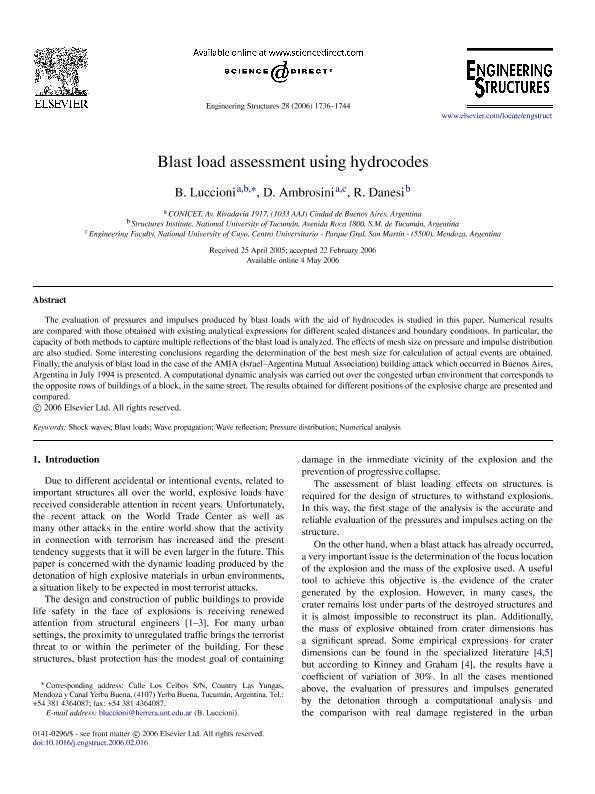Mostrar el registro sencillo del ítem
dc.contributor.author
Luccioni, Bibiana Maria

dc.contributor.author
Ambrosini, Ricardo Daniel

dc.contributor.author
Danesi, Rodolfo Francisco

dc.date.available
2019-09-13T18:45:16Z
dc.date.issued
2006-12
dc.identifier.citation
Luccioni, Bibiana Maria; Ambrosini, Ricardo Daniel; Danesi, Rodolfo Francisco; Blast load assessment using hydrocodes; Elsevier; Engineering Structures; 28; 12; 12-2006; 1736-1744
dc.identifier.issn
0141-0296
dc.identifier.uri
http://hdl.handle.net/11336/83566
dc.description.abstract
The evaluation of pressures and impulses produced by blast loads with the aid of hydrocodes is studied in this paper. Numerical results are compared with those obtained with existing analytical expressions for different scaled distances and boundary conditions. In particular, the capacity of both methods to capture multiple reflections of the blast load is analyzed. The effects of mesh size on pressure and impulse distribution are also studied. Some interesting conclusions regarding the determination of the best mesh size for calculation of actual events are obtained. Finally, the analysis of blast load in the case of the AMIA (Israel–Argentina Mutual Association) building attack which occurred in Buenos Aires, Argentina in July 1994 is presented. A computational dynamic analysis was carried out over the congested urban environment that corresponds to the opposite rows of buildings of a block, in the same street. The results obtained for different positions of the explosive charge are presented and compared.
dc.format
application/pdf
dc.language.iso
eng
dc.publisher
Elsevier

dc.rights
info:eu-repo/semantics/openAccess
dc.rights.uri
https://creativecommons.org/licenses/by-nc-sa/2.5/ar/
dc.subject
Shock Waves
dc.subject
Blast Load
dc.subject
Wave Propagation
dc.subject
Wave Reflection
dc.subject.classification
Ingeniería Civil

dc.subject.classification
Ingeniería Civil

dc.subject.classification
INGENIERÍAS Y TECNOLOGÍAS

dc.title
Blast load assessment using hydrocodes
dc.type
info:eu-repo/semantics/article
dc.type
info:ar-repo/semantics/artículo
dc.type
info:eu-repo/semantics/publishedVersion
dc.date.updated
2019-09-13T14:01:56Z
dc.journal.volume
28
dc.journal.number
12
dc.journal.pagination
1736-1744
dc.journal.pais
Países Bajos

dc.journal.ciudad
Amsterdam
dc.description.fil
Fil: Luccioni, Bibiana Maria. Universidad Nacional de Tucumán. Facultad de Ciencias Exactas y Tecnología. Instituto de Estructuras "Ing. Arturo M. Guzmán"; Argentina. Consejo Nacional de Investigaciones Científicas y Técnicas. Centro Científico Tecnológico Conicet - Tucumán; Argentina
dc.description.fil
Fil: Ambrosini, Ricardo Daniel. Universidad Nacional de Cuyo. Facultad de Ingeniería. Instituto de Mecánica Estructural y Riesgo Sísmico; Argentina. Consejo Nacional de Investigaciones Científicas y Técnicas. Centro Científico Tecnológico Conicet - San Juan; Argentina
dc.description.fil
Fil: Danesi, Rodolfo Francisco. Universidad Nacional de Tucuman. Facultad de Cs.exactas y Tecnología. Laboratorio de Estructuras; Argentina. Consejo Nacional de Investigaciones Científicas y Técnicas. Centro Científico Tecnológico Conicet - Tucumán; Argentina
dc.journal.title
Engineering Structures

dc.relation.alternativeid
info:eu-repo/semantics/altIdentifier/doi/https://dx.doi.org/10.1016/j.engstruct.2006.02.016
dc.relation.alternativeid
info:eu-repo/semantics/altIdentifier/url/https://www.sciencedirect.com/science/article/pii/S0141029606001131?via%3Dihub
Archivos asociados
